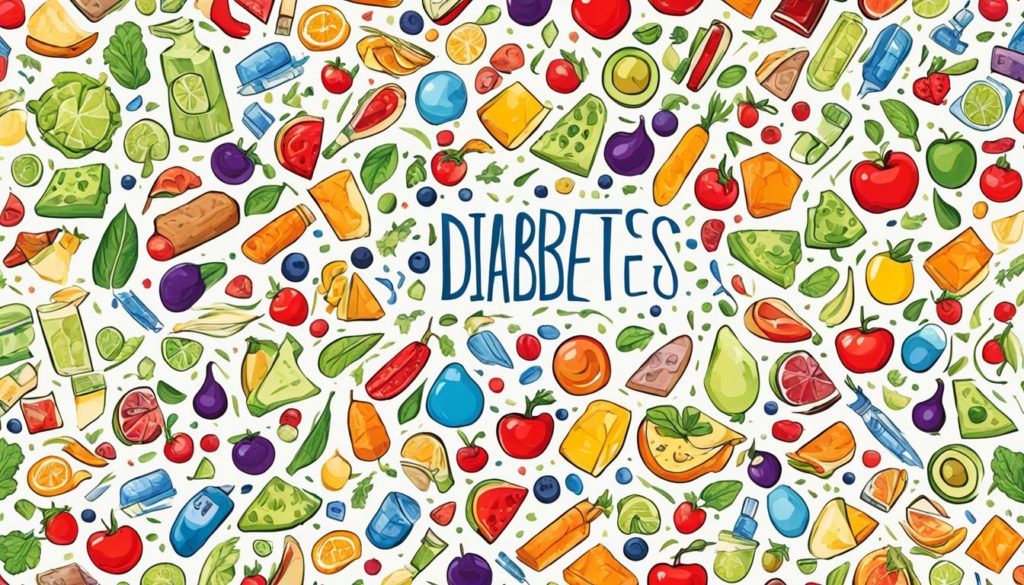Over 34 million Americans are living with diabetes. The numbers are rising every year. This highlights the need for effective diabetes management and robust care models. Our guide explores the latest research and innovative strategies for handling diabetes.
It helps patients and healthcare providers alike. With evidence-based tips from AvoMD and the American Association of Clinical Endocrinology (AACE), our guide is packed with info. You will find details on drugs, lifestyle changes, and more, making this guide essential for understanding diabetes care.
Our guide takes a comprehensive approach. It folds in clinical decision-making with an emphasis on integrated care models. From behavioral practices to tech advancements, it offers a complete view on managing diabetes.
Key Takeaways
- The prevalence of diabetes in the United States highlights the need for comprehensive management approaches.
- This guide provides evidence-based recommendations from AvoMD and AACE.
- An integrated diabetes care model includes pharmacological and non-pharmacological therapies.
- The guide covers advanced diabetes management techniques, such as Continuous Glucose Monitoring (CGM).
- Emphasis on clinical decision-making enhances the effectiveness of diabetes care strategies.
Introduction to Diabetes and Its Types
Diabetes is a serious health issue affecting many people worldwide. It’s key to know the different kinds of diabetes. There are mainly three types: Type 1, Type 2, and gestational diabetes. Each requires its own care and medication strategies.

Type 1 Diabetes
Type 1 diabetes happens when the body’s immune system attacks its own insulin-making cells. If you have Type 1 diabetes, you’ll need insulin for life. Managing it well means keeping your blood sugar stable. This is done through insulin, diet changes, and staying active.
Type 2 Diabetes
Type 2 diabetes usually starts in adults older than 45 but is now more common in younger people. This condition occurs when your body resists insulin or doesn’t make enough. To deal with Type 2, people often change their lifestyle.
Type 2 diabetes medications like metformin can also help. These treatments aim to control your blood sugar and reduce health risks.
Gestational Diabetes
Gestational diabetes affects some women during pregnancy. It can harm both the mother and baby. Doctors screen for it during prenatal checks. Managing it involves special diets, exercise, and possibly insulin.
It’s vital to listen to your doctor to keep blood sugar in check and avoid problems.
Importance of Early Diagnosis
Finding diabetes early is super important. It helps doctors take fast action, which is key in managing diabetes and prediabetes well. The ADA’s Standards of Care in Diabetes—2023 say catching diabetes early is critical. It helps lower the risks and stops worse problems later on.

Knowing the risks early lets doctors make custom plans to stop prediabetes from getting worse. Studies back up the need for regular checks to find diabetes early. This keeps it from turning into full-blown diabetes.
Here’s how catching diabetes early compares with catching it late:
| Aspect | Early Diagnosis | Late Diagnosis |
|---|---|---|
| Health Outcomes | Generally better control and fewer complications | Higher risk of severe complications |
| Prediabetes Management | Higher success rates in preventing diabetes | Increased chances of diabetes progression |
| Diabetes Risk Factors | Identified and managed earlier | Often discovered after onset of diabetes |
Finally, stressing diabetes early diagnosis and good prediabetes management shows how crucial it is to take action early. Spotting the risks early leads to better health and a better life for those at risk.
Diabetes Treatment Options
Managing diabetes means using a mix of treatments that fit each person’s unique needs. We look at all the therapy choices out there, from meds to lifestyle changes. This way, we can make life better for those with this long-term illness.
Pharmacological Therapies
Diabetes meds cover a wide range, all aimed at keeping blood sugar in check. These include:
- Insulin Therapy: A must for Type 1 diabetes and sometimes for Type 2.
- Oral Medications: Like metformin, mainly for Type 2 diabetes.
- Injectable Medications: Such as GLP-1 receptor agonists for both Type 1 and Type 2 diabetes.
Non-Pharmacological Therapies
Non-med-based therapy for diabetes is also key. It’s about changing your lifestyle and other actions that don’t involve meds. These include:
- Dietary Changes: Making diet plans to manage blood sugar well.
- Exercise: Staying active to help insulin work better and boost health.
- Behavioral Counseling: Working on mental aspects that impact diabetes care.
Individualized Treatment Plans
Customizing diabetes care is crucial to get the best results. This means building a care plan that looks at your medical history, how you live, and your diabetes challenges. With tools like continuous glucose monitors, doctors can see your sugar levels in real time. This helps them make smart choices. By blending meds and lifestyle changes in the right way, each person can manage their diabetes better.
| Treatment Type | Examples |
|---|---|
| Pharmacological | Insulin, Metformin, GLP-1 agonists |
| Non-Pharmacological | Diet, Exercise, Behavioral Counseling |
Insulin Therapy for Diabetes
Insulin therapy is key in controlling diabetes. This is especially true for Type 1 diabetes and advanced Type 2 diabetes patients. They may need it more than oral meds. Knowing about different insulin types and how to use them is vital for good blood sugar control. It’s also important to keep track of blood sugar levels and adjust insulin correctly to be safe and effective.
Types of Insulin
There are several insulin types based on how quickly they work and how long they last:
- Rapid-acting insulin: Starts working within 15 minutes and lasts for about 2 to 4 hours.
- Short-acting insulin: Begins working within 30 to 60 minutes and remains effective for 5 to 8 hours.
- Intermediate-acting insulin: Takes 1 to 3 hours to start working and lasts for 12 to 16 hours.
- Long-acting insulin: Begins to work several hours after injection and lasts for 24 hours or longer.
Methods of Administration
Nowadays, there are many ways to take insulin, making it easier for patients:
| Method | Description |
|---|---|
| Insulin Injections | The traditional and most common method where insulin is injected subcutaneously using a syringe, pen, or needle. |
| Insulin Pumps | Devices that deliver continuous insulin subcutaneously through a catheter, offering precise and adjustable dosing. |
| Inhalable Insulin | Rapid-acting insulin delivered through an inhaler, providing an alternative to injections for meal-time insulin. |
Monitoring and Adjusting Dosage
It’s crucial to monitor and adjust insulin doses correctly for effective diabetes management. By regularly checking blood glucose, patients and doctors can make smarter insulin dosing decisions. Technology like Continuous Glucose Monitoring (CGM) systems gives instant glucose data. This helps in quickly adjusting insulin levels. Always work with health experts to customize insulin treatment. This should reflect your diet, physical activity, and health status.
Oral Medications for Diabetes
Oral meds are key in managing diabetes. They help control blood sugar and lessen problems from diabetes. Each one works differently and affects the body in its own way.
Sulfonylureas
Sulfonylureas help your body make more insulin. Drugs like glipizide and glyburide lower blood sugar well. But, they can cause low blood sugar and make you gain weight.
Metformin
Metformin is the go-to for type 2 diabetes. It lowers blood sugar made by your liver and makes insulin work better. One big plus of metformin is it controls blood sugar without extra weight or low blood sugar. It also helps your heart, offering many benefits in one pill.
SGLT2 Inhibitors
SGLT2 inhibitors, like canagliflozin and dapagliflozin, work by making you pee out extra sugar. Studies show SGLT2 inhibitors for heart failure cut down on heart issues and hospital stays for diabetes patients. So, they’re good for both sugar control and heart health.
Choosing the right oral medications for diabetes means looking at how each one works and their benefits. Sulfonylureas increase insulin, metformin is good for your heart and weight, and SGLT2 inhibitors help with sugar and the heart.
| Medication Class | Mechanism | Primary Benefits | Common Concerns |
|---|---|---|---|
| Sulfonylureas | Stimulate insulin secretion | Lower blood glucose | Hypoglycemia, weight gain |
| Metformin | Reduce hepatic glucose production | Glycemic control, cardiovascular benefits | GI disturbances |
| SGLT2 Inhibitors | Inhibit glucose reabsorption in kidneys | Glycemic control, heart failure benefits | Genital infections |
Lifestyle Changes for Diabetes Control
Making changes in your lifestyle is key to controlling diabetes. You can see a big difference in your health by altering everyday habits. We will look at important strategies such as changing your diet, getting active, and keeping weight in check.
Dietary Modifications
A carefully thought-out diabetes diet is essential. It keeps your blood sugar levels even. Eating whole grains, lean proteins, and lots of veggies helps balance carbs. This balance is crucial for handling diabetes.
Adding the right foods to your diabetes diet and watching how much you eat prevents blood sugar spikes. It’s also very important to eat less processed and sweet foods. This helps keep your blood sugar at a good level.
Physical Activity
Being active regularly is great for diabetes management. Activities like walking, swimming, or bike riding lower blood sugar and increase insulin’s effectiveness.
Knowing how exercise impacts your blood sugar helps tailor your workout. This ensures you get the most benefit from it.
Weight Management
Weight management is crucial in controlling diabetes. Staying at a healthy weight with diet and exercise lowers the risk of diabetes problems.
Diet changes and being active are central to managing your weight. This approach is a key part of treating diabetes effectively.
Advanced Diabetes Management Techniques
The way we handle diabetes care is changing. Advanced diabetes management is key to helping patients do better. We’re looking at new methods that change the game, like continuous glucose monitoring (CGM) and the growing use of diabetes telehealth.
Continuous Glucose Monitoring (CGM)
CGM devices have changed diabetes care for the better. They give updates on blood sugar levels as they happen. This lets patients act fast to keep their levels stable.
CGM provides ongoing info, unlike the old way of checking with finger pricks. It helps stop too low or too high sugar levels. With CGM, patients can easily change what they eat, how much they move, and their meds as needed.
Telehealth and Remote Monitoring
Adding diabetes telehealth to care improves access to specialized help. Patients talk to their doctors without going to their offices. This is really helpful for people living far away from clinics.
Telehealth and CGM together mean better care and more active patients. Doctors can give help and advice all the time, not just during visits. This makes diabetes management better for everyone.
Alternative Treatments for Diabetes
Exploring alternative diabetes treatments adds valuable options beyond usual therapies. We look at herbal remedies for diabetes and acupuncture’s benefits. These approaches can help manage diabetes alongside standard treatments.
Herbal Supplements
Many people use herbal remedies for diabetes to help control blood sugar. Ginseng, fenugreek, and bitter melon are popular for their positive effects. These herbs may lower blood sugar and improve how the body uses insulin. They work best with healthy eating and medicines.
| Herbal Supplement | Potential Benefits |
|---|---|
| Ginseng | May improve insulin sensitivity and lower fasting blood sugar levels. |
| Fenugreek | Has been shown to help reduce blood sugar levels and improve glucose tolerance. |
| Bitter Melon | Contains compounds that may mimic insulin and lower blood glucose levels. |
Acupuncture
The acupuncture benefits in diabetes care are becoming well-known. This traditional Chinese method uses thin needles in specific body points. It aims to stimulate nerves and improve energy flow. Acupuncture might help control blood sugar and ease neuropathy. When used with other treatments, it can enhance overall health.
In conclusion, alternative diabetes treatments like herbal supplements and acupuncture support diabetes care. They offer extra help while respecting patient choices and cultural traditions.
Treatment Options for Type 2 Diabetes
Managing Type 2 diabetes well requires a complete plan that addresses immediate and extended needs. It’s key to create a plan that fits the person, ensuring blood sugar is well-managed with as little treatment hassle as possible.
Initial Management Strategies
Beginning treatment for Type 2 diabetes usually includes changing lifestyle and starting on medications. Key steps are:
- Dietary Changes: Focusing on meals full of fiber, whole grains, and proteins that are low in fat.
- Physical Activity: Getting regular exercise to boost insulin efficiency and improve health.
- Medication: Starting with drugs like Metformin to help control blood sugar.
These steps are vital to get blood sugar under control from the start. They help prepare for ongoing disease management.
Long-Term Treatment Plans
The goal of managing diabetes over the long term is to maintain and enhance early successes. This involves regular checks and tweaking treatment plans as needed. Techniques include:
- Personalized Medication Plans: Tailoring drug plans based on how the patient reacts and any side effects.
- Continuous Glucose Monitoring (CGM): Employing cutting-edge technology to keep a close eye on glucose levels to adjust treatment quickly.
- Regular Healthcare Visits: Making sure the treatment plan stays up to date through ongoing health checks.
Using these methods helps patients to manage their diabetes well over time. It improves their life quality and lowers the chance of serious diabetes-linked issues.
Holistic Approaches to Diabetes Treatment
In recent years, more people have turned to holistic diabetes treatment. This method treats the whole person, not just symptoms. It includes mind and body practices like behavioral therapy and mindfulness. These strategies help control blood sugar and improve life quality for those with diabetes.
Behavioral Therapy
Behavioral therapy is key in holistic approaches to diabetes. It helps patients form healthier habits and find ways to cope. Programs focused on behavior can lead to better blood sugar levels and a balanced life. Studies confirm its big role in improving care for diabetes patients. When used with other treatments, behavioral therapy works even better. It adds to a well-rounded plan for managing diabetes.
Mindfulness and Stress Reduction
Mindfulness and stress reduction are vital for holistic diabetes care. Stress can make diabetes worse, so managing it is important. Techniques like meditation, deep breathing, and yoga help lower stress. This supports better blood sugar control. Adding these practices to daily life brings big improvements in health and diabetes control. Stress reduction shows how mental and physical health are linked. It highlights a balanced, effective way to care for diabetes holistically.
FAQ
What are the main types of diabetes and how are they different?
There are three main types of diabetes. Type 1 diabetes happens when the body attacks its insulin-producing cells. Type 2 diabetes, which is more common, occurs when there’s insulin resistance. Gestational diabetes shows up during pregnancy and may raise the risk of Type 2 diabetes later on.
Why is early diagnosis important in managing diabetes?
Finding diabetes early is key. It lets doctors start treatments soon, which can stop complications. The ADA points out that catching it early helps control diabetes better. This reduces risks like heart disease later.
What are the pharmacological treatment options for diabetes?
Diabetes can be treated with insulin and oral medicines. Insulin helps manage blood sugar. Oral medications like sulfonylureas and metformin adjust glucose levels. Doctors pick treatments based on the patient’s health and life.
Can you explain the different types of insulin and their uses?
Insulin is key for managing diabetes and comes in many types. There’s rapid-acting, short-acting, intermediate, and long-acting insulin. Each type works differently. Patients might inject it or use pumps for ease.
What are some common oral medications used to treat diabetes?
Some well-known diabetes pills are sulfonylureas, metformin, and SGLT2 inhibitors. Sulfonylureas boost insulin release. Metformin cuts down sugar made by the liver. SGLT2 inhibitors help the kidneys remove sugar. These medicines can also help the heart.
How do lifestyle changes impact diabetes management?
Changes in diet and exercise are vital for handling diabetes. Such changes can better glucose control and cut down on medication needs. They also lessen the chance of related health issues. These actions are central to treating diabetes effectively.
What advanced techniques are available for diabetes management?
New tools like Continuous Glucose Monitoring (CGM) give real-time sugar levels. Telehealth lets patients talk to doctors from afar. These options make managing diabetes easier. They also improve life quality for those with diabetes.
Are there alternative treatments for diabetes, and are they effective?
Some people try herbal supplements and acupuncture as extra treatments. Research sometimes shows benefits. Yet, these should be combined with regular treatments. Doctors should supervise to keep things safe and effective.
What strategies are recommended for managing Type 2 diabetes?
First steps in treating Type 2 diabetes include lifestyle tweaks and metformin. Later, more medicines or insulin might be needed. This depends on how the patient responds. The aim is good blood sugar control and making treatment easy.
How can a holistic approach benefit diabetes treatment?
Looking at diabetes treatment wholly can help a lot. This includes focusing on both mind and body. Reducing stress through mindfulness can improve health. It leads to better diabetes control by looking at the big picture of health.


